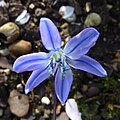Scilla siberica: Difference between revisions
reword addition per MOS:NOTED, add {{reflist}} |
Darorcilmir (talk | contribs) →Distribution: movement of text |
||
| Line 7: | Line 7: | ||
'''Siberian squill''' ('''''Scilla siberica'''''; also called '''wood squill''') is a [[bulb|bulbous]] [[perennial plant|perennial]], grown for its nodding blue flowers in early [[spring (season)|spring]]. It naturalizes rapidly from seed. |
'''Siberian squill''' ('''''Scilla siberica'''''; also called '''wood squill''') is a [[bulb|bulbous]] [[perennial plant|perennial]], grown for its nodding blue flowers in early [[spring (season)|spring]]. It naturalizes rapidly from seed. |
||
==Distribution== |
|||
Siberian squill is native to southwestern [[Russia]], the [[Caucasus]], and [[Turkey]]. Despite its name, it is not native to [[Siberia]]. |
|||
==Description== |
==Description== |
||
Revision as of 07:42, 27 March 2013
| Siberian squill | |
|---|---|

| |
| Scientific classification | |
| Kingdom: | Plantae |
| Clade: | Tracheophytes |
| Clade: | Angiosperms |
| Clade: | Monocots |
| Order: | Asparagales |
| Family: | Asparagaceae |
| Subfamily: | Scilloideae |
| Genus: | Scilla |
| Species: | S. siberica
|
| Binomial name | |
| Scilla siberica | |
Siberian squill (Scilla siberica; also called wood squill) is a bulbous perennial, grown for its nodding blue flowers in early spring. It naturalizes rapidly from seed.
Description
The flowers have six petals and six stamens, and are arranged singly or in racemes of two or three. Petals may be reflexed to the horizontal when sunlight is bright, but are more often cup-shaped. The flowers are usually blue, but those of Scilla siberica var. alba are white. The stamens of Scilla are separate, unlike those of the related genera Puschkinia and Chionodoxa, which are fused into a tube. The pollen is dark blue.
After flowering, the flower stems become limp as capsules (pods) mature. At maturity, the capsules become purple and split open, releasing small, dark brown seeds. When the seeds are mature, the leaves wither and the plant goes dormant until the next spring.
Seedlings are hollow-leaved.
Cultivation
At 15 cm (5.9 in), Siberian squill is suitable to be planted in grass, and will spread by seed to form large colonies that go dormant by the time grass needs to be mowed. In the Midwest US, it is becoming invasive in some situations.[1]
Gallery
-
seed capsules
-
bulbs
-
Klepacza Park in Łodz, Poland
-
Siberian squill
References
- ^ "Scilla siberica (Siberian Squill): Minnesota Wildflowers". Minnesota Wildflowers.




